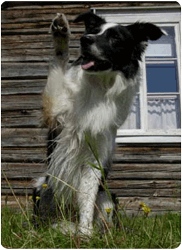 HOW DID THIS HANDLING STYLE START
HOW DID THIS HANDLING STYLE START
Everything started when Janita's Border Collie Tekla became deaf in 2003. Janita had been handling Tekla one obstacle at a time, using mostly verbal commands like "here" or the names of the obstacles. When Tekla lost the ability to hear, she was always going to wrong obstacles and obviously the verbal cues wouldn't work anymore.
Janita had two choises, either stop doing agility with Tekla or try to learn a consistent way to handle her without verbal commands. With Tekla's help Janita learned to understand agility from dog´s perspective. She found out what type of signals a dog reacts to on the course. At first it was purely learning from mistakes. Janita tried different things: what happens if the chest is pointing that way, what about if it's pointing that way, what if I take the steps like this or keep my hand here and there.
SIX IMPORTANT THINGS
Gradually Janita learned ways to tell her dog CONSISTENTLY where to go and what to do on an agility course. We think that there are six major things that are affecting to dogs in the course: movement and positioning, contact with the dog, chest's laser point, legs, hands and voice. All the techniques are designed to have all six basic elements of handling supporting the same thing and making advancing of the dog in agility course as easy and effective as possible.
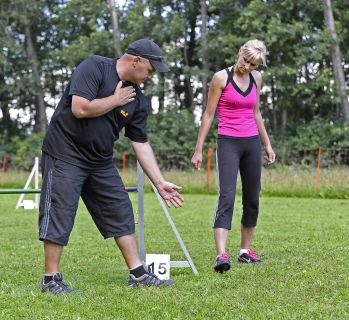 OVER 30 DIFFERENT TECHNIQUES
OVER 30 DIFFERENT TECHNIQUES
We have given a lot of thought to developing the different techniques over the years and have tried to optimize the best way to execute them. For us it's not enough that a dog reacts right way to our handling every now and then. We want them to react perfectly with maximum speed and the fastest lines at least 99 times out of 100. Therefore there are quite strict guidelines for every technique how to execute them to obtain perfect lines for the dog.
For learning and teaching purposes we have named individual techniques. Unified vocabulary makes teaching much more effective and it makes learning much easier for the students. Everyone knows exactly how to execute certain technique and they do it the same way every time. This way the dog can always move on the optimal lines with the optimal speed. When the handlers remember the name of the technique and the rules how to execute it, they can practice it in their mind without the dog.
You don't actually have to "learn" many things for all techniques. If you only understand how those six basic things work, you can figure out yourself how to execute the techniques the easiest way from the dog's point of view. In our training sessions we spend more time for thinking than running...
When the execution of the techniques becomes a routine, the handlers can concentrate fully on their dogs on the course.
All the steps and turns are automatic. When the techniques are done the same way every time, the dog can anticipate quite early what the handler wants the dog to do next.
The ideas for the first 20 techniques came from the dogs´ natural reactions to handlers' cues. You don't really even have to teach these techniques to your dog. If you know how to do them, your dog will react to them naturally. Because the body language is the same for dogs all around the world, these techniques work with all dogs instantly. For example in summer 2011, Janita borrowed a dog that she had never seen before and showed all the techniques with that dog. The owner was amazed, how could her dog manage to perform all the right moves with these techniques so naturally and easily without practicing them first. Like mentioned earlier, this is DOGS´SYSTEM, and it's based on their natural response to our body language!
EXAMPLE VIDEO
Example of how natural this handling is for a dog.
IN THIS VIDEO Elina Jänesniemi is handling a dog (not her own) who is seeing agility obstacles for the fourth time in her life. When a handler knows what to do, it's natural for a dog...
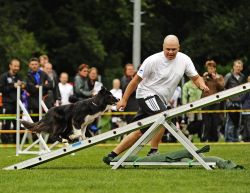 EASY WAY FOR SUCCESS
EASY WAY FOR SUCCESS
Because we utilise dogs´ natural behaviour we often get very good results with quite young dogs without having to do a lot of repetitions at early age. Five dogs we have trained have been in a Finnish national team as early as at 2 years of age. This system also enables handlers to consistently run high quality clear runs if there is no mental barrier preventing the success.
The most important point of the method is that it just makes sense for the dogs. Trainers' mentioned in side are having a high clear round percentage in competitions and almost all of them are near optimal high quality runs. For example Janita and Elina made over 60 clear runs (each) in competitions in 2011.
Nowadays there are over 30 different techniques.
After Janita figured out the basics for the techniques, Jaakko has been the innovator developing ways to take things even further. We are now using some new techniques that we teach our dogs (those are not natural for them) and it has enabled us to successfully negotiate even the most difficult sequences.
There is no end in sight for the development.
Jaakko is very innovative and keeps his mind open.
He is constantly thinking if something could be done even better and easier for the dog.
NO LIMITS!
We are not stuck with any limiting rules. If we discover that something we have been doing so far can be done better, we will make a change. Also we think it's really binding if there are too many rules telling you what you can't do. We firmly believe one can do almost anything, without any limits! The only rule is to do the things we choose to do perfectly.
It is important to keep in mind that whatever we do has to be consistent and in line with other aspects of our handling. One can never give dog mixed signals and there must always be a balance between all the things we use and reinforce for our dogs in agility.
HANDLE LINES, NOT OBSTACLES
Beside these six important things affecting our dogs naturally, we have some guidelines for course reading. We are not handling individual obstacles as such, we are handling the dog's running lines. We use the techniques to give the dog as much information as early as possible. This allows the dog to perform the right obstacle with correct speed for the situation in question. We always try to handle so that dog has the right obstacle in her sight as soon as possible. We never ever say that they are wrong in the agility course. We encourage them to work independently without any doubt or holding back. They are basically always allowed to go to the obstacle they see in front of them and it's our job to get them always to see right ones!
CRITICAL POINTS
We also think there are something we refer as critical points. Those points are places where you have
to be on the course to be able to negotiate the sequence in question perfectly. Different techniques are like tools that help you to be on those points on time, even though you were not the fastest runner. The faster your dog is compared to you, the bigger advantage you get from mastering all the different techniques. In our training we first teach everybody all the techniques. The last step is to choose the best suitable techniques for you and your dog.
It is like giving the handlers alphabets and teaching them how to write. In the end everybody writes their own individual signature.
COOPERATION FRIENDS
We have cooperated with Mikko Aaltonen and Mari Kaplas for several years. We see agility in a very similar way. We started a project called Tehotiimi (2007-2009) together. It was meant for people who aimed for the top level. Many of the Tehotiimi handlers have had a lot of success afterwards. In the end of 2011 we started to work together with a new project called NextLevel. It has been rewarding working together with Mikko and Mari who have underlined the importance of rhythm changes in handling.
WHY ONEMIND
After giving many seminars abroad people started to talk about J&J system. Because we want to give the credit of this system to our patient dogs who taught it to us, we decided to name it, but not with our names. We came up with the name ONEMIND. We want to understand our dogs on the course so well, that it feels like we have one mind with them. There is not a more satisfying feeling in the world than having full wordless understanding with your best companion on an agility course. We think that everyone should know the principles of ONEMIND - system because it's only fair for the dogs, they always give everything for their handlers in agility course. With this system you never have to be angry with your dog about going to wrong obstacles. Your dog only tries to follow your handling cues and it's your responsibility to give him the right lines...
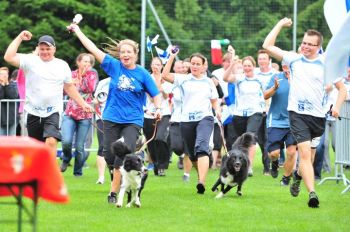 FAST WAY FOR RESULTS
FAST WAY FOR RESULTS
We only train average once / twice a week, but we start working with puppies already at young age. Training with puppies consists of reinforcing their natural ability to read our body language and is our common playground. Practically it's learning some basic rules for agility field. We teach them to focus on the right things (obstacle / handler focus drill) and teach them to tolerate the handler moving away from the puppy leaving it independently finish the given task. Training is playing, learning to know each other, bonding, keeping contact and mostly just HAVING FUN TOGETHER.
PUPPY TRAINING
Janita asked Jaakko Suoknuuti with Zen and Jaakko Knuutti with Vimma to be "the guinea pigs" in her experiment for a new way to prepare puppies for agility. Both Jaakkos were willing to try that and they both were in Finnish WC team when their dogs were 2 years old. Third member of that team was Janita herself with Cosmo. This team won the team jumping competition in WC 2007 with several seconds.
After this first experiment Janita trained her own Hitti and Elina Jänesniemi's Omie the same way. Also those both dogs were in Finnish national team as 2 years old (Hitti won Nordic Championships and Omie were 4th in WC). While training Hitti and Omie, we filmed a dvd called "From Puppy to Champion", unfortunately it's only in Finnish and Swedish. Later Janita's way to start teaching puppies has spread all over the Finland.
Our dogs have been in top shape up to very old age so we know for a fact that we are not harming our dogs. If we had even a smallest suspicion that our way of working would harm them, we would never do it.
Our dogs are huge part of our lives. They all are members of our family and we care for them dearly.
TEKLA
What happend to Tekla? Tekla was six years old when she became totally deaf. After Janita learned to base her handling on the dog's point of view, she started to make a lot of clean runs. Even as a 10-year-old deaf grandma Tekla still won big high level competitions in Finland. When Janita started to use the same method with her other dog Cosmo she instantly got about 3 seconds away from Cosmo's course times. Cosmo was not the fastest dog, but because with ONEMIND - system you can get the best out of your dog, Cosmo was able to earn 9th place in WC 2007.
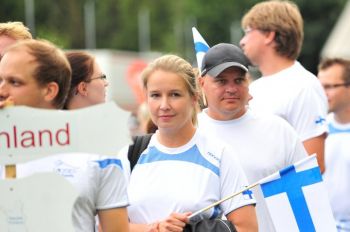 PLEASE ASK!
PLEASE ASK!
When we start to talk about agility, no one can shut us up. We love to tell people what we have discovered about agility and dogs over the years. We love to have people to ask us "why?" and challenge the way we are thinking and doing things, because then we know that they want to understand and learn. Hearing new aspects and having to justify our own opinions always forces us to test and develop ONEMIND -method even further.
We really have a lot of faith in what we are doing, otherwise we would not teach it! One of the biggest reasons we wanted to travel abroad to give agility seminars was the sheer will to want to share our knowlegde with as many agility people all over the world as possible. We want to thank the many many people around the world who have welcomed us with open minds and hearts wanting to here our thoughts and giving us new ideas. We have been privileged to be able to take part in many interesting discussions. You all have given us so much and made our lives interesting and fun. THANK YOU!
ONLINE TRAINING
Click the links in this page, traning sites is also in English.
INTERNATIONAL TRAINING WEEK IN FINLAND
More information

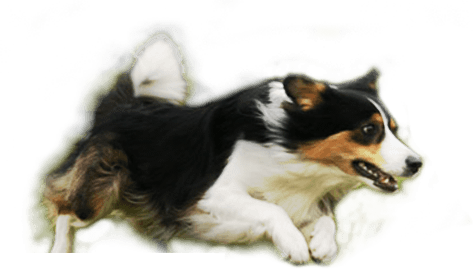
 HOW DID THIS HANDLING STYLE START
HOW DID THIS HANDLING STYLE START OVER 30 DIFFERENT TECHNIQUES
OVER 30 DIFFERENT TECHNIQUES EASY WAY FOR SUCCESS
EASY WAY FOR SUCCESS FAST WAY FOR RESULTS
FAST WAY FOR RESULTS PLEASE ASK!
PLEASE ASK!